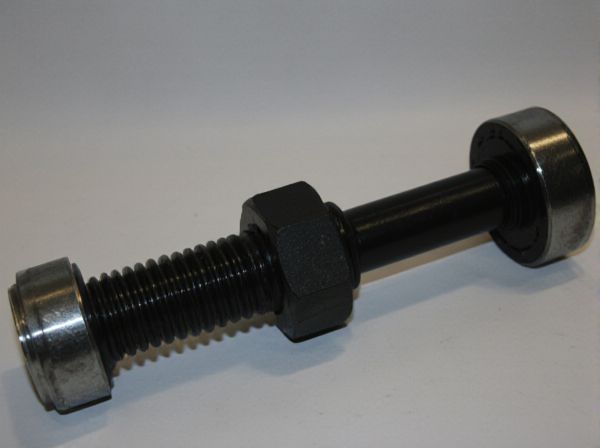
Photo illustration: Universal Joint Coupling vs Flexible Coupling
Universal joint couplings provide efficient torque transmission between shafts with significant angular misalignment, ideal for applications requiring high flexibility and durability. Flexible couplings accommodate minor shaft misalignments and absorb vibrations, protecting equipment from shock loads and reducing wear. Understanding your application's torque, angular displacement, and misalignment needs helps determine whether a universal joint coupling or flexible coupling offers optimal performance and longevity.
Table of Comparison
| Feature | Universal Joint Coupling | Flexible Coupling |
|---|---|---|
| Function | Transfers rotary motion between misaligned shafts | Absorbs vibrations and slight misalignments |
| Design | Rigid cross-shaped joint with needle bearings | Elastomeric or rubber elements for flexibility |
| Steering Application | Connects steering shaft segments at angles | Reduces steering vibrations and noise |
| Durability | High mechanical strength, requires lubrication | Wear-prone, needs periodic replacement |
| Cost | Moderate, depends on bearing quality | Lower initial cost, higher maintenance |
| Common Usage | Used in steering shafts with angular displacement | Used to isolate vibrations in steering systems |
Introduction to Universal Joint and Flexible Couplings
Universal joints transmit rotary motion between two shafts that are not in a straight line, accommodating angular misalignment with high torque capacity. Flexible couplings connect shafts allowing for slight misalignments, vibration damping, and shock absorption, enhancing machinery lifespan. Both coupling types are essential in mechanical systems for efficient power transmission under varying alignment conditions.
Key Functions of Universal Joint Couplings
Universal joint couplings primarily transmit rotary motion between shafts that are not aligned, accommodating angular misalignment up to 45 degrees while maintaining constant velocity ratio. They consist of two yokes connected by a cross-shaped intermediate member, enabling torque transfer in applications requiring flexibility in shaft alignment. Universal joints are essential in automotive drive shafts and industrial machinery where compensating for shaft deflection and misalignment ensures smooth power transmission and reduces wear.
Primary Features of Flexible Couplings
Flexible couplings offer primary features such as the ability to accommodate misalignment between connected shafts, vibration damping, and shock absorption, which protect mechanical components from wear and damage. Unlike universal joint couplings that handle angular misalignment with a cross-shaped joint, flexible couplings provide torsional flexibility through elastomeric or metallic elements, enhancing operational smoothness and reducing noise. These characteristics make flexible couplings ideal for applications requiring smooth torque transmission and protection against dynamic loads.
Design Differences: Universal Joint vs Flexible Coupling
Universal joint couplings feature a cross-shaped pivot design allowing angular misalignment and rotational movement between shafts, enabling torque transmission at varied angles. Flexible couplings use elastomeric or metallic elements that absorb vibration, compensate for minor misalignments, and reduce shock loads, ensuring smooth power transmission. The universal joint emphasizes mechanical articulation through rigid yokes and needle bearings, while flexible couplings rely on material flexibility and deformation within their components.
Performance Comparison Under Misalignment
Universal joint couplings offer superior torque transmission under high angular misalignment up to 45 degrees but exhibit increased vibration and wear at extreme angles, affecting long-term performance. Flexible couplings accommodate smaller misalignment angles typically up to 5 degrees with reduced vibration and better shock absorption, enhancing operational smoothness. Performance under misalignment depends on application-specific requirements, with universal joints favored in heavy-duty scenarios and flexible couplings preferred for precision and low-maintenance environments.
Torque Transmission Capabilities
Universal joint couplings offer high torque transmission capabilities with the ability to accommodate angular misalignment up to 45 degrees, making them ideal for heavy-duty applications in automotive and industrial machinery. Flexible couplings transmit torque efficiently while absorbing vibrations and minor misalignments, but their torque capacity is generally lower compared to universal joints. Selecting between the two depends on the specific torque requirements and the degree of misalignment in the mechanical system.
Maintenance and Durability Factors
Universal joint couplings require regular lubrication and periodic inspection to prevent wear and ensure smooth operation, as their exposed components are prone to contamination and fatigue. Flexible couplings typically demand less maintenance due to their enclosed design and use of elastic materials, which absorb misalignment and reduce stress on connected shafts, enhancing durability. Choosing between the two depends on operational conditions, with universal joints offering higher torque capacity but flexible couplings providing longer service life in environments with vibration and misalignment.
Applications in Various Industries
Universal joint couplings are widely used in automotive drive shafts and heavy machinery for transmitting torque and accommodating angular misalignment. Flexible couplings find applications in pumps, compressors, and conveyor systems where vibration damping and slight shaft misalignment are critical. Both coupling types play essential roles in industries such as manufacturing, aerospace, and agricultural equipment, ensuring reliable power transmission and reduced equipment wear.
Cost Implications and Selection Criteria
Universal joint couplings generally incur higher costs due to their complex design and maintenance requirements, while flexible couplings offer a more cost-effective solution with lower upfront and servicing expenses. Selection criteria hinge on factors such as torque capacity, misalignment tolerance, operating speed, and environmental conditions, with universal joints preferred for high torque and angular misalignment and flexible couplings chosen for moderate misalignment and vibration damping. Evaluating these parameters alongside total lifecycle costs ensures optimal coupling choice for specific industrial applications.
Summary: Choosing the Right Coupling for Your Needs
Universal joint couplings offer high torque transmission and flexibility for misaligned shafts, making them ideal for heavy-duty applications with angular displacement. Flexible couplings provide vibration damping and accommodate minor misalignments, ensuring smoother operation in sensitive machinery. Selecting the right coupling depends on factors such as load capacity, alignment tolerance, and the specific mechanical demands of your system.
 caratoz.com
caratoz.com